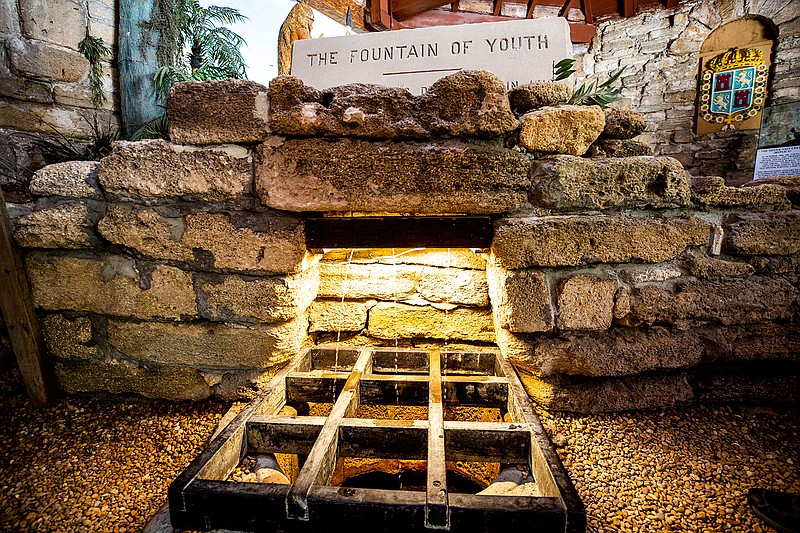Long before Florida became the country's 27th state, the Timucua people and Spanish explorers inhabited St. Augustine, specifically the site of what's likely the Sunshine State's oldest attraction.
The Fountain of Youth Archaeological Park contains centuries of history on its 15 acres and sign-ins from visitors dating back to 1868. It's a place where "legend meets history," as one historian wrote, and modern-day visitors can drink from the same spring that Spanish explorer Juan Ponce de Leon likely did.
It'd be wrong to classify the St. Augustine stop as merely a theme park, an attraction or a historical site. It's more of an "edutainment" experience with interactive history and an archaeological site where significant artifacts have been unearthed over the years.
Besides, who wouldn't want a chance at eternal youth with a simple drink of water?
"Everyone, in the back of their mind, hopes for a magic bullet. They hope for the thing that gives eternal youth - whether it's a sip of water from a spring or a blessing from someone," said John Fraser, owner and general manager of the park.
In search of Bimini
In early March 1513, Ponce de Leon set off from Puerto Rico with three ships, hoping to find the island of Bimini. On Easter Sunday, March 27, 1513, he first sighted Florida and sailed along the state's coast before a storm battered his crew for two days.
On April 2, Ponce de Leon took a reading at 30 degrees and 8 minutes north latitude, about 20 miles north of St. Augustine. From there, the explorer turned south and landed in the coastal Timucua village of Seloy, located within an area that had been inhabited by Native Americans for 4,000 years.
Since he believed his landing site was an island, Ponce de Leon called his new discovery La Florida because he discovered it at Easter during the Festival of the Flowers (Pascua de Flores).
Ponce de Leon reportedly marveled at the health of the Timucua people, who thrived on their supply of clean water, fresh game, seafood, beans, squash and maize.
"This fountain of fresh, free-flowing water and the healthy, vigorous Timucua who lived here became 'proof' to the discovery of a mythological pool that offered eternal youth," wrote historian Dr. Roger Smith in his book about the Fountain of Youth site.
Some historians and Fraser point to signs they consider evidence of Ponce's landing - a cross made from 27 blocks of coquina, an artifact still on display near the fountain, and a salt cellar with an inscription on vellum detailing Ponce de Leon's discovery. Others believe that Ponce de Leon actually landed near modern-day Melbourne Beach.
Fifty-two years later, Don Pedro Menendez de Aviles followed in Ponce de Leon's footsteps when he landed near the Timucua village with the mission of beating back French intruders and colonizing the land. European diseases would eventually ravage the native Timucua population, along with English raids in the 1700s, but the city of St. Augustine and Fountain of Youth site have endured for more than 450 years.
The Fountain of Youth site was claimed by Spain for more than two centuries until Britain reigned for two successive decades. In 1783, Spain regained dominion of Florida and the site was given to the Arnau family in 1807.
Henry H. Williams, a St. Augustine business owner familiar with the site's history, purchased the property from Paul Arnau in 1868 and began selling cups of water for 5 cents while providing a guest book for visitors to sign.
"Luella Day MacConnell bought the place in 1901. From 1901 to 1927, she was the one that kind of pushed it into attraction status," Fraser said.
The Fraser era
Now, the Fountain of Youth site has remained in the Fraser family for almost 100 years, ever since Walter B. Fraser, the grandfather of current owner John Fraser, purchased the property in July 1927.
Walter Fraser continued elevating the site's status as an attraction for visitors from the Northeast and Midwest who stopped on their way to Miami, but he was someone who sought to maintain the historical nature of the property.
The Great Depression took its toll on the site as Walter Fraser and his wife, Adeline, sought to find ways to attract new business. One of his ideas was planting a citrus grove on the property.
"Somewhere in this little field, a worker was getting ready to plant an orange tree and the shovel hit a skull," John Fraser said.
The Smithsonian Institution sent archaeologists who would uncover more than 90 Christian burial sites of Indigenous people who converted to Catholicism in St. Augustine.
In the years to come, Walter Fraser would embark on landscaping and building projects to improve the grounds. Skip ahead more than two decades and the owner was envisioning new ways to combine history and science. These innovations came in the form of a planetarium show and a two-story Discovery Globe beginning in 1959, both of which still operate to this day.
Walter's grandson, John Fraser, was a high schooler on the attraction's payroll in 1973, when the minimum wage was $1.79 in Florida. He would welcome visitors and put bumper stickers on their cars.
"My first job was sitting on a bench right near the front gate. The cars would come in and I'd say, 'Welcome to the Fountain of Youth, where are you all from?' " said Fraser.
He wears a lot of hats while wandering the 15-acre grounds he now owns as he checks to see how performers are faring with their regularly scheduled demonstrations. His voice features prominently as the narrator of several shows. And he's tasked with overseeing the legacy of his grandfather and those who came before him at the Fountain of Youth site.
'More than just
a drink of water'
While John Fraser strives to honor the history of his Fountain of Youth site above all else, he also comes from a business background and knows how to draw people in.
"History, in and of itself, does not sell," he said. "Why do you come here? You come here because you can drink from the same spring that Ponce de Leon drank from."
Fraser recalls a lesson he learned from his grandfather regarding attraction management - "Something to see, something to eat, something to buy." As such, the site not only contains shows and history to engage visitors but a barbecue restaurant and a gift shop stocked with postcards, T-shirts and bottled water from the spring.
The Fountain of Youth now sees between 900-1,500 modern-day visitors daily. Because of the COVID-19 pandemic, Fraser said the attraction was forced to temporarily close by city mandate and business is down about 30% compared to a year prior. But attendance is picking up again.
After all, the site has a sort of undying appeal that has drawn tourists for more than 150 years.
"I think that initially, people come in here for a drink of water from a famous spring," Fraser said. "And they leave going, 'Oh, wow, this is a lot more.' And they realize that we are so much more than just a drink of water."
When visiting, it isn't hard to gaze out toward the Matanzas River and imagine a time when modern development didn't sprawl along the East Coast, when the Timucua people fished and Spanish ships dotted the horizon.
If you go: The Fountain of Youth Archaeological Park is open 9 a.m.-6 p.m. daily at 11 Magnolia Ave. in St. Augustine. Tickets are $18 for adults, $17 for seniors ages 60 years and older and $10 for children ages 6-12. St. Johns County residents receive half-price admission at the ticket window. Discounts are also available for active military and AAA members. The attraction is also pet-friendly. For more information and tickets, call 904-829-3168 or visit fountainofyouthflorida.com.



